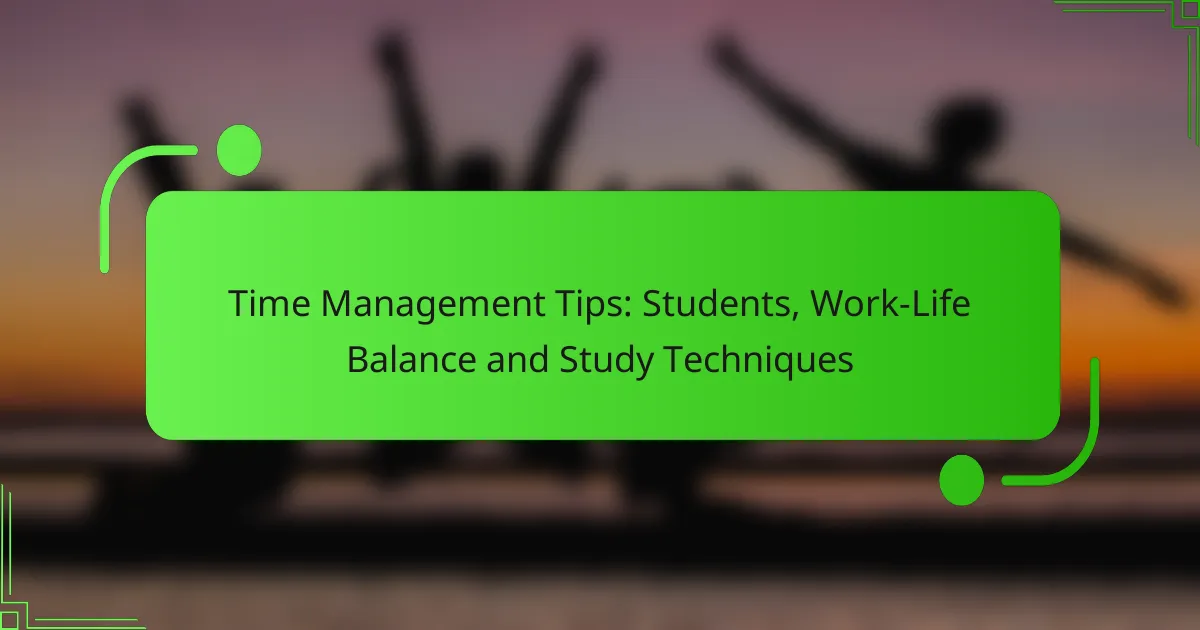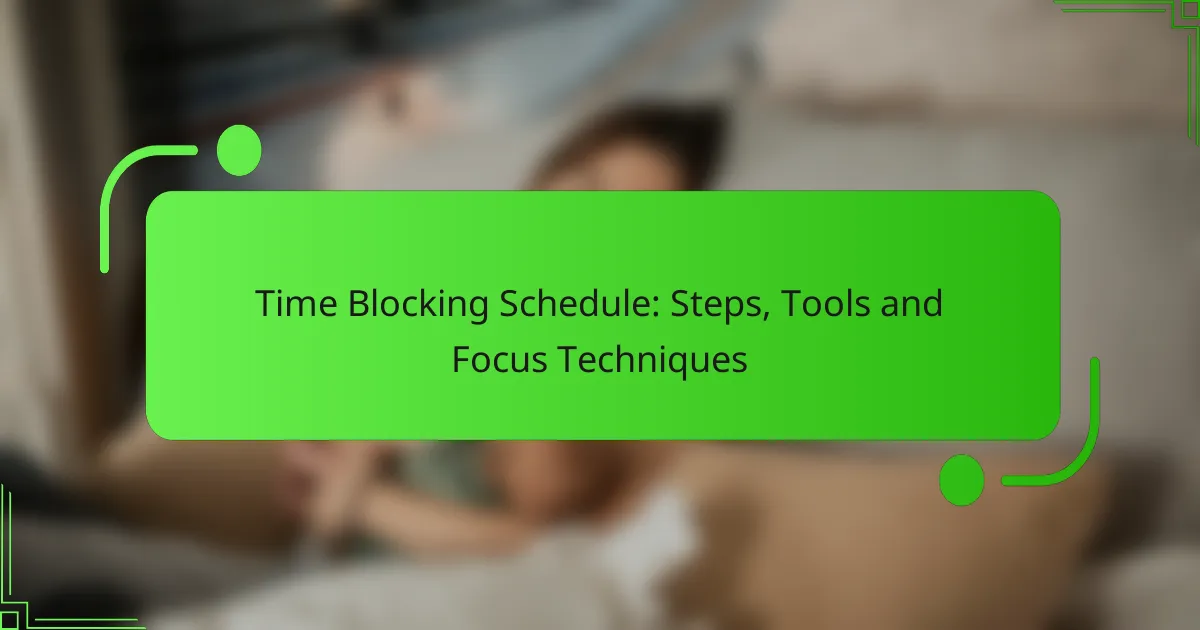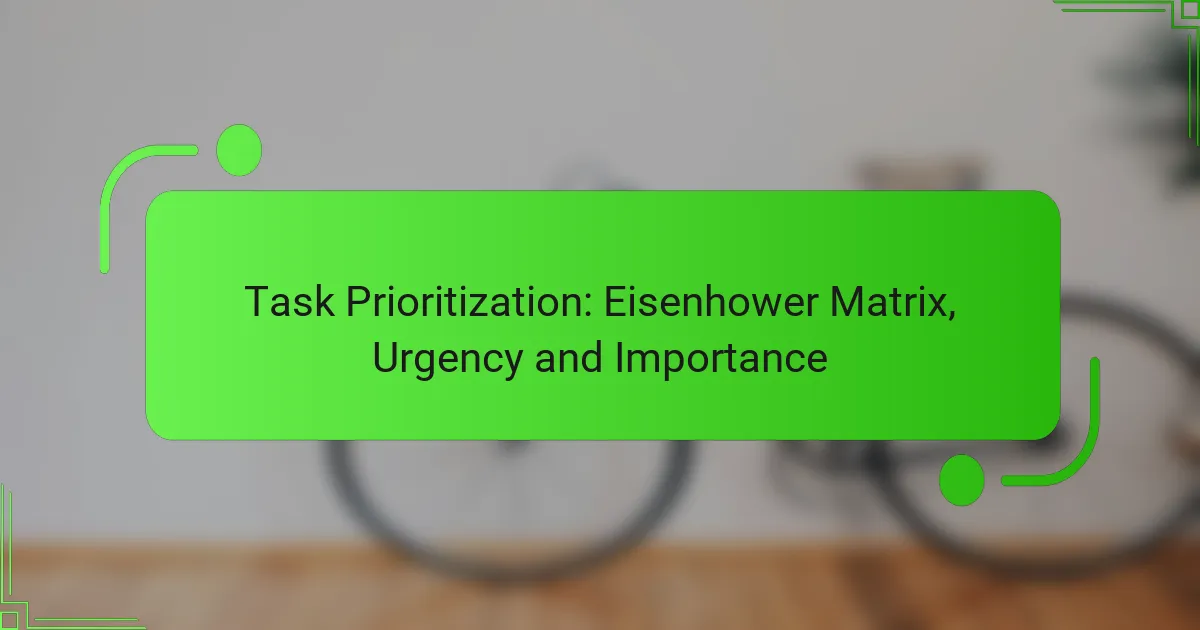Mastering time management is essential for students striving to balance academic demands with personal life. By prioritizing tasks, setting clear goals, and adopting effective study techniques, students can enhance their productivity and reduce stress. Implementing structured schedules and incorporating leisure activities can lead to a healthier work-life balance, ultimately fostering a more fulfilling educational experience.
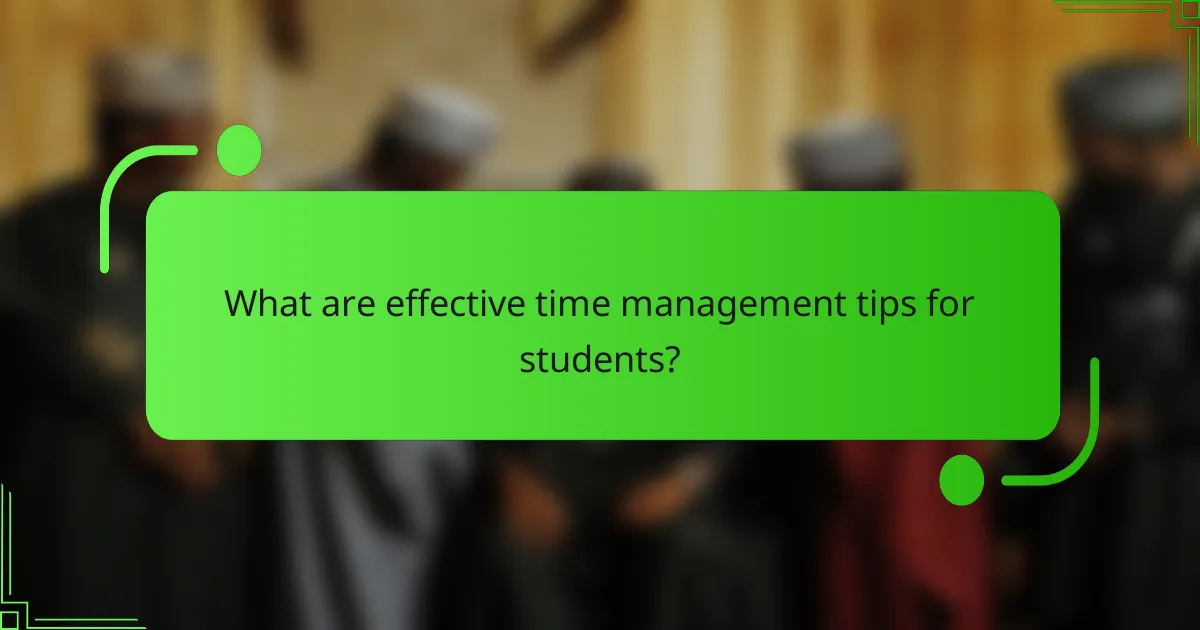
What are effective time management tips for students?
Effective time management tips for students focus on prioritizing tasks, setting clear goals, and maintaining a structured schedule. By implementing these strategies, students can enhance their productivity and achieve a better work-life balance.
Prioritizing tasks with the Eisenhower Matrix
The Eisenhower Matrix is a powerful tool for prioritizing tasks based on urgency and importance. It divides tasks into four quadrants: urgent and important, important but not urgent, urgent but not important, and neither urgent nor important.
To use this matrix, list your tasks and categorize them accordingly. Focus first on tasks that are both urgent and important, then schedule time for important but not urgent tasks to prevent them from becoming emergencies. Avoid spending too much time on tasks that fall into the last two quadrants.
Using the Pomodoro Technique for focused study
The Pomodoro Technique enhances focus and productivity by breaking study sessions into short intervals, typically 25 minutes, followed by a 5-minute break. This method helps maintain concentration and reduces mental fatigue.
To implement this technique, choose a task, set a timer for 25 minutes, and work on it until the timer goes off. After four Pomodoros, take a longer break of 15-30 minutes. This structure can help students manage their time effectively while studying for exams or completing assignments.
Setting SMART goals for academic success
SMART goals are Specific, Measurable, Achievable, Relevant, and Time-bound objectives that guide students in their academic pursuits. Setting SMART goals helps clarify what needs to be accomplished and provides a clear roadmap for success.
For example, instead of saying “I want to study more,” a SMART goal would be “I will study for two hours every weekday evening to prepare for my upcoming math exam.” This specificity helps students stay focused and motivated.
Creating a weekly planner for classes and assignments
A weekly planner is essential for organizing classes, assignments, and study sessions. By visually mapping out the week, students can allocate time for each task and avoid last-minute cramming.
To create an effective planner, include all class schedules, assignment due dates, and study periods. Color-coding tasks can also help differentiate between subjects or priorities. Regularly updating the planner ensures that students stay on track and manage their time efficiently.
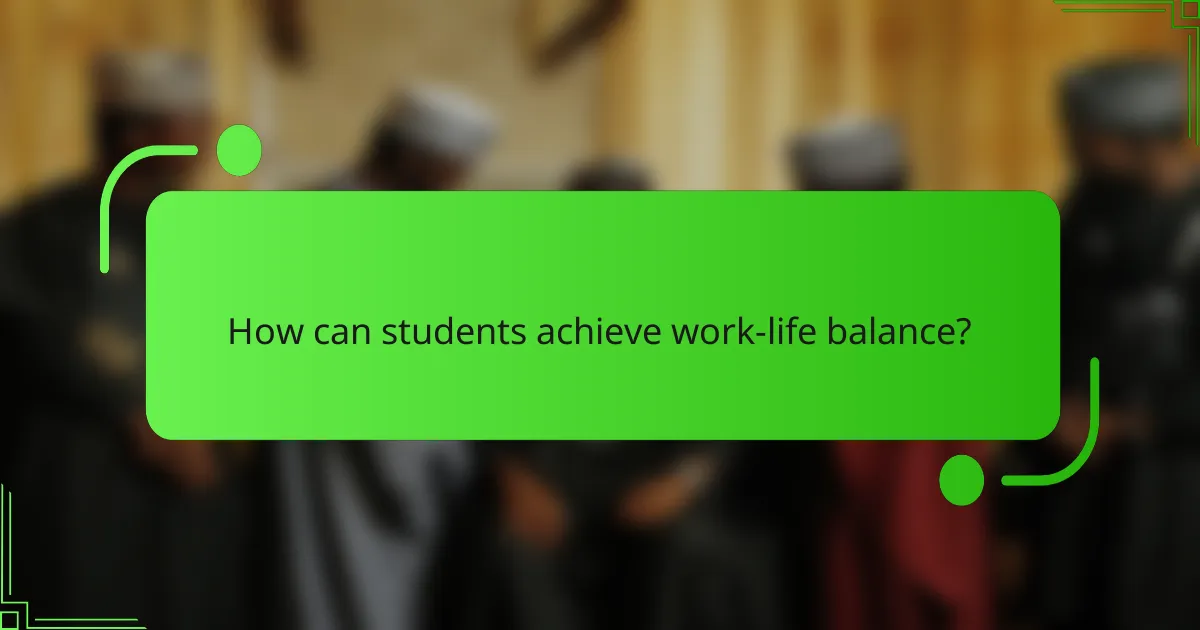
How can students achieve work-life balance?
Students can achieve work-life balance by effectively managing their time between academic responsibilities and personal activities. This involves setting clear boundaries, incorporating leisure into their schedules, and practicing mindfulness to reduce stress.
Establishing boundaries between study and personal time
Setting boundaries is crucial for maintaining a healthy work-life balance. Students should designate specific hours for studying and personal activities, ensuring that each area receives adequate attention without overlap.
For example, a student might choose to study from 6 PM to 9 PM and reserve the rest of the evening for relaxation or socializing. Communicating these boundaries to friends and family can help minimize interruptions.
Incorporating leisure activities into the schedule
Leisure activities are essential for recharging and maintaining motivation. Students should intentionally schedule time for hobbies, exercise, or social events, treating them as important as study sessions.
A practical approach is to allocate at least one or two evenings per week for leisure, allowing for flexibility based on academic demands. This balance can enhance overall productivity and well-being.
Practicing mindfulness and stress management
Mindfulness techniques can significantly improve students’ ability to manage stress and maintain focus. Practices such as meditation, deep breathing, or yoga can be integrated into daily routines to promote mental clarity.
Students might start with just five to ten minutes of mindfulness exercises each day, gradually increasing the duration as they become more comfortable. This practice can help reduce anxiety and improve concentration during study sessions.
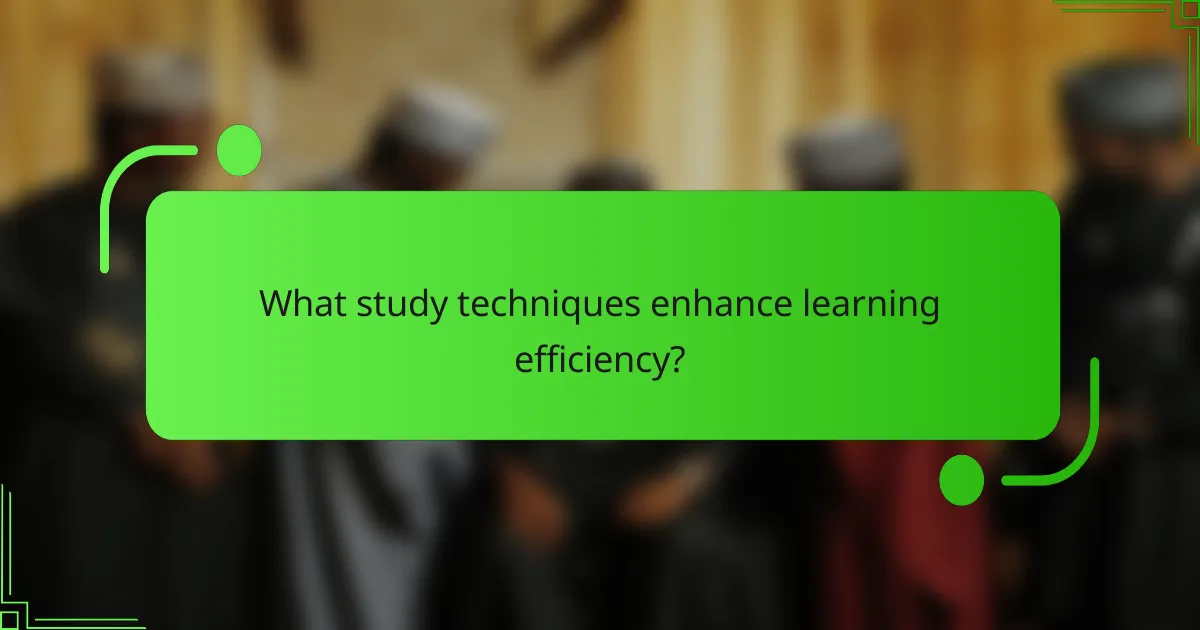
What study techniques enhance learning efficiency?
Effective study techniques can significantly improve learning efficiency by promoting better retention and understanding of material. Key methods include active recall, spaced repetition, and collaborative learning through study groups.
Active recall for better retention
Active recall involves retrieving information from memory rather than passively reviewing notes. This technique strengthens neural connections and enhances retention. For instance, using flashcards or self-quizzing can be effective ways to implement active recall.
To maximize benefits, aim to test yourself frequently on the material you’ve learned, ideally within a few hours after studying. Avoid cramming; instead, integrate active recall into your daily study routine.
Spaced repetition for long-term memory
Spaced repetition is a learning technique that involves reviewing information at increasing intervals over time. This method helps combat forgetting and reinforces memory retention. Tools like Anki or Quizlet can facilitate spaced repetition by scheduling reviews based on your performance.
To effectively use spaced repetition, start by reviewing material shortly after learning it, then gradually extend the intervals between reviews. This approach can lead to more durable memory formation compared to massed practice.
Utilizing study groups for collaborative learning
Study groups can enhance learning through collaboration and discussion, allowing students to share different perspectives and clarify concepts. Engaging with peers can also motivate individuals to stay accountable and committed to their study goals.
To make the most of study groups, establish clear objectives for each session and ensure everyone participates. Avoid letting one person dominate the discussion; instead, encourage equal contributions to foster a richer learning environment.
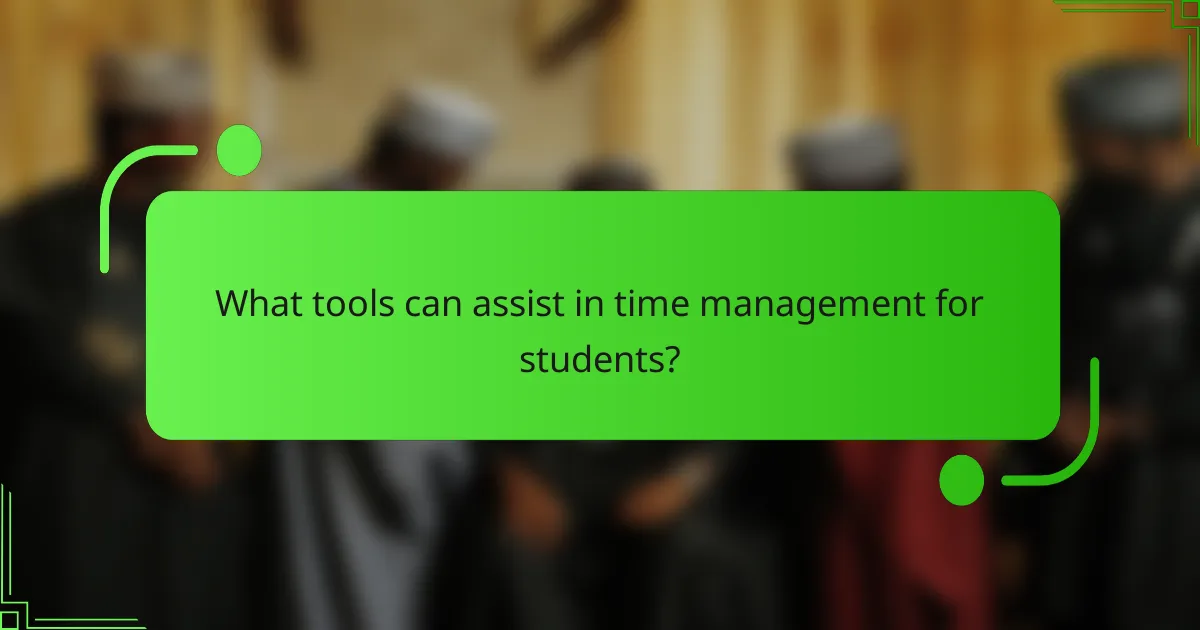
What tools can assist in time management for students?
Students can benefit from various tools designed to enhance time management, helping them balance academic responsibilities and personal life. Digital planners, time tracking apps, and calendar tools are among the most effective resources available.
Using digital planners like Todoist
Digital planners such as Todoist allow students to organize tasks efficiently. These tools enable users to create to-do lists, set deadlines, and prioritize assignments, ensuring that important tasks are not overlooked.
When using Todoist, students can categorize tasks by project or subject, making it easier to focus on specific areas. Setting reminders can also help maintain accountability and keep students on track with their deadlines.
Employing time tracking apps like RescueTime
Time tracking apps like RescueTime help students understand how they spend their time. By monitoring activities, these applications provide insights into productivity patterns, allowing students to identify distractions and areas for improvement.
Students can set goals within RescueTime to limit time spent on non-productive activities. Regularly reviewing these insights can lead to better time allocation and more effective study habits.
Leveraging calendar tools like Google Calendar
Google Calendar is a powerful tool for students to manage their schedules. It allows users to create events, set reminders, and share calendars with peers, facilitating collaboration on group projects and study sessions.
To maximize its effectiveness, students should block out time for classes, study sessions, and personal commitments. Color-coding different activities can provide a quick visual reference, helping students maintain a balanced schedule.
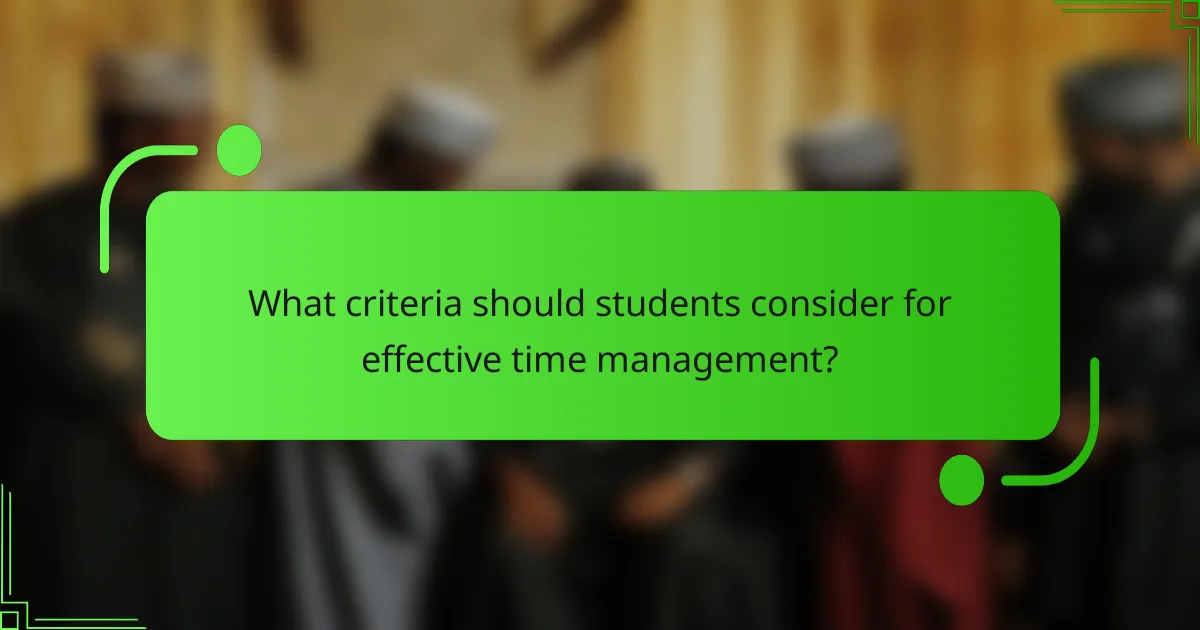
What criteria should students consider for effective time management?
Students should focus on understanding their personal productivity patterns, identifying peak focus hours, and setting clear priorities to manage their time effectively. By evaluating these criteria, students can create a structured schedule that enhances their study techniques and work-life balance.
Assessing personal productivity patterns
To assess personal productivity patterns, students should reflect on their daily routines and identify when they feel most alert and engaged. Keeping a journal for a week can help track energy levels and focus throughout different times of the day.
Consider categorizing tasks based on energy levels: high-energy tasks may include studying or project work, while low-energy tasks could involve administrative duties or light reading. This approach allows students to allocate their time more efficiently.
Identifying peak focus hours
Identifying peak focus hours is crucial for maximizing study effectiveness. Most people experience natural fluctuations in energy, often peaking in the morning or late afternoon. Students should experiment with different study times to discover their personal peak hours.
Once peak focus hours are identified, students can schedule their most challenging tasks during these times. For example, if a student finds they concentrate best from 10 AM to 12 PM, they should prioritize studying complex subjects during that window.
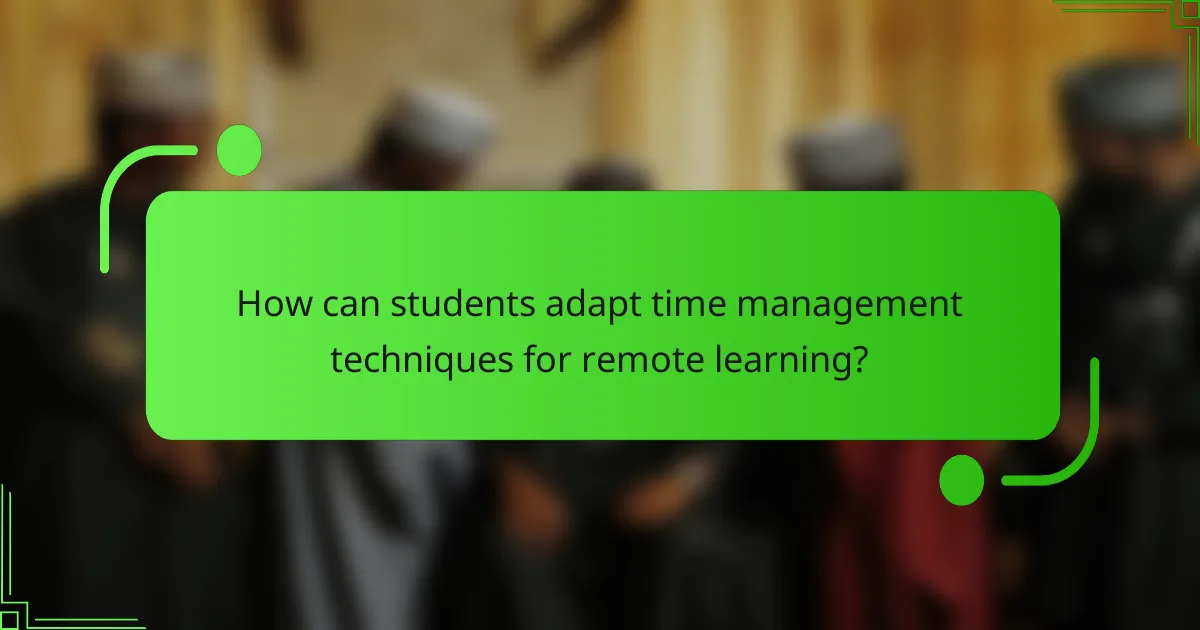
How can students adapt time management techniques for remote learning?
Students can effectively adapt time management techniques for remote learning by establishing clear boundaries and routines that mimic a traditional classroom environment. This involves creating a structured schedule that prioritizes study time while minimizing distractions.
Creating a dedicated study space at home
Designating a specific area in your home for studying can significantly enhance focus and productivity. Choose a quiet spot with minimal interruptions, good lighting, and all necessary supplies within reach. This space should be distinct from areas associated with relaxation or entertainment.
Consider personalizing your study area with motivational quotes or images to inspire you. Keeping this space organized can also help maintain a clear mindset, making it easier to transition into study mode.
Implementing structured daily routines
Structured daily routines are crucial for maintaining a sense of normalcy in remote learning. Start by setting consistent wake-up and study times, ideally mirroring your school schedule. This helps regulate your body clock and enhances focus during designated study periods.
Incorporate short breaks into your routine to prevent burnout. For example, use the Pomodoro Technique: study for 25 minutes, then take a 5-minute break. This method can improve retention and keep you engaged throughout your study sessions.
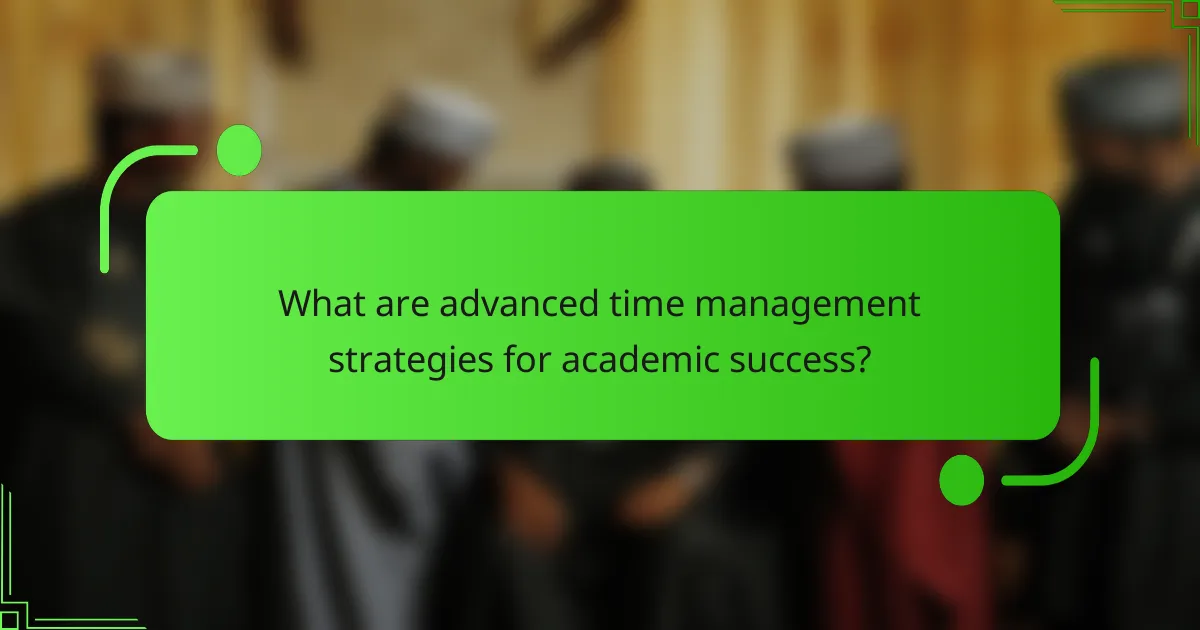
What are advanced time management strategies for academic success?
Advanced time management strategies for academic success involve prioritizing tasks, setting clear goals, and utilizing effective planning tools. These methods help students balance their studies with personal commitments, leading to improved academic performance and reduced stress.
Prioritization Techniques
Prioritization is essential for effective time management. Students can use methods like the Eisenhower Matrix, which categorizes tasks into four quadrants based on urgency and importance. This helps identify which tasks to tackle first and which can be delegated or postponed.
Another approach is the ABCD method, where tasks are labeled as A (most important), B (important), C (nice to do), and D (delegate). This simple system allows students to focus on high-impact activities that contribute significantly to their academic goals.
Goal Setting and Planning
Setting SMART goals—Specific, Measurable, Achievable, Relevant, and Time-bound—provides clarity and direction. For instance, instead of saying “study more,” a student might set a goal to “complete three chapters of biology by Friday.” This specificity enhances motivation and accountability.
Using planners or digital tools like Google Calendar can help students visualize their schedules. Breaking down larger projects into smaller tasks with deadlines can prevent last-minute cramming and promote steady progress.
Time Blocking and Scheduling
Time blocking involves dedicating specific chunks of time to particular tasks or subjects. For example, a student might allocate two hours on Monday evenings for math and one hour for reading. This structured approach minimizes distractions and enhances focus.
When scheduling, students should consider their peak productivity times. Some may work best in the morning, while others are more alert in the evening. Aligning study sessions with these periods can lead to more efficient learning.
Review and Adjust
Regularly reviewing progress is crucial for effective time management. Students should assess what strategies are working and which need adjustment. This could involve weekly reflections on completed tasks and upcoming deadlines.
Flexibility is key; if a particular method isn’t yielding results, students should be open to trying new techniques. Adapting to changing circumstances ensures that time management strategies remain effective throughout the academic year.
